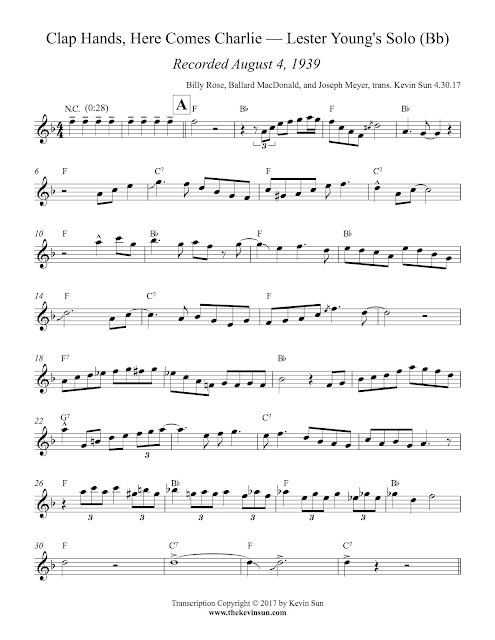Lester Young on "Clap Hands, Here Comes Charlie"
"Clap Hands! Here Comes Charley!" is a 1925 pop song that the Basie band repurposed into a high velocity big band vehicle. The recording from August 1939 from the period after the expiration of the band's Decca contract features one of the great solo breaks: eight Eb quarter notes played in succession by Lester Young. I came upon this solo first in Lewis Porter's Lester Young, where Porter notes that the recording nears the upper bound of tempos documented throughout his career (this particular recording is around quarter equal 284). Of course, I wanted to hear Lester playing in his most up-tempo context, and this solo is iconically that, beginning with the unstoppable solo break.
This cut was recorded in the middle of the Basie band's extended run at the Famous Door in New York City, from July 11 through September 3, 1939. After that, the band went to the West Coast, where they played a run from October 5 through 11 at the Paramount Ballroom in Los Angeles. Dexter Gordon was there on the night of October 5, 1939, and he recalls it vividly in Frank Büchmann-Møller's superbly detailed You Just Fight For Your Life: The Story of Lester Young:
"They opened with 'Clap Hands Here Comes Charlie,'" Gordon concludes, "and Lester came out soloing—and he was just fantastic. I really loved the man. He was melodic, rhythmic, had that bittersweet approach. And, of course, in his pre-Army days he had such a zest for living. It felt so good to hear him play." (90)
I can only imagine being 16 and seeing Lester out in front of the band on this tune. At the time of the recording, Lester was not yet 30, but seemingly all the documented work from this period is earth-shatteringly strong. Porter references this particular solo numerous times throughout Lester Young, as it contains numerous trademark aspects of his playing from this period, including the "honk" at the end of the first chorus, a middle D that Lester I think lays into with the palm D key depressed as well, giving some extra fatness to the sound as well as more space for all the air to burst out of the horn.
I'm also fairly convinced that Stan Getz most likely learned this solo early on. When I was much younger, I learned Getz's solo on "S-H-I-N-E" from West Coast Jazz (1955), another burning tune in Eb with fairly straightforward, diatonic changes. Lester's repeated D quarter notes, chromatic minor thirds shape in the second eight bars of the second chorus, and false fingerings at the end of the second chorus all make cameos throughout that solo, which became apparent once I learned it. In general, learning more of Lester's solos has connected many of the dots of language I've come across in later players, which is satisfying in its own way, although nothing matches the joy of just inhabiting this exciting, long-ago sound through playing these solos.
*sad imitation here


Comments
Post a Comment